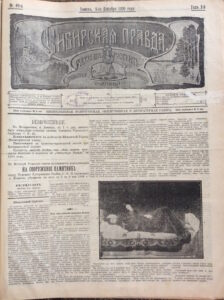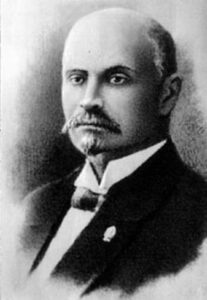One aspect of the Ignatii Dvernitskii murder that I haven’t really explored, yet, is the trial itself. This is partly because, as mentioned previously, the case was tried by military tribunal on Nov. 23, 1909, and the records have likely been lost. Because the authorities closed military tribunals to the public, moreover, there was only limited reporting on the trial itself. Sibirskaia pravda, the newspaper of the nationalist Soiuz russkogo naroda, reported on the trial in its December 5, 1909 issue (pictured).

Cover page of the December 5, 1909 issue of Sibirskaia Pravda
While there are quite a few points of interest in the Sibirskaia pravda article (including the republication of the photograph that supposedly shown Ignatii’s body refusing to decompose), I’m particularly interested in the note that one of the accused, Kuimov (misspelled as Kuinov in the article) was represented by an attorney with the last name Vologodskii.
While the Sibirskaia pravda reporting does not give the first name and patronymic of the attorney, it seems likely that he was P. V. Vologodskii, a very well-known Socialist Revolutionary (SR) lawyer in revolutionary-era Tomsk.
If it is indeed the same person (and hopefully it won’t take too much digging to confirm this information), that would help explain the accusations that Kuimov was involved with the SRs. Vologodskii also helps bring the the story of Ignatii’s death full circle, moreover, as Vologodskii was a key lawyer involved in the trails related to the 1905 pogrom, trials that also took place in 1909 Tomsk (August).

P.V. Vologodskii. Image via Wikimedia commons, public domain.
His biography is fascinating. From the Tomsk region, he trained as a lawyer in 1880s St. Petersburg, but was expelled for poor behaviour, and managed to finish his studies back in Tomsk. He was on the Tomsk city duma (city council, basically), from 1901-1917, and was a founding member of the Tomsk SRs in 1905. He would eventually go on to become editor of Sibirskaia zhizn’, just before the 1917 Revolution. In January 1918 he became part of the anti-Bolshevik, Provisional Siberian Government, and served as foreign minister. All of this to say, the threads of the Ignatii murder go in so many fascinating directions, and I need to pay more attention to the trial and those involved, even if I never find the trial records.

